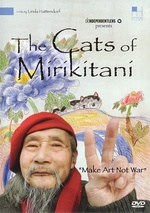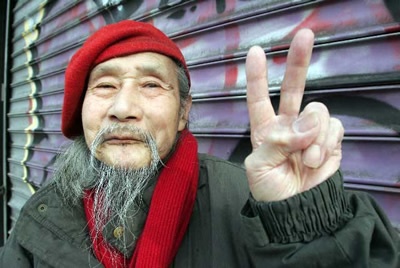Curiosity may have killed the cat. But in the case of The Cats of Mirikitani, a 2006 documentary gem just recently released on DVD, the combination of curiosity and cats results in a beautiful, moving tale of redemption.
In early 2001, New York filmmaker Linda Hattendorf is intrigued by the elderly Asian homeless man in her neighborhood who draws colorful crayon and ink images of cats. Eighty-year-old Jimmy Tsutomu Mirikitani seems an artist of professional caliber—and unabashedly refers to himself as Grand Master Artist. He lives on the streets in extreme poverty, yet will not accept money for anything but his artworks.
Hattendorf’s casual conversations with Mirikitani evolve into an unlikely friendship. She learns that he is Japanese American and obsessed, seemingly to the point of madness, with World War II. At times, he spends hours in freezing weather, sketching evocative, angry images of concentration camps and the Hiroshima atomic bomb.
She senses that within the enigma of Mirikitani’s life is a compelling story, and decides to document it as a film, which unfolds over a five-year period.
Others help her explore Mirikitani’s past. Roger Shimomura, an artist and art professor at the University of Kansas, explains how he accidentally learned about Mirikitani while browsing eBay and later befriended him during visits to New York.
While educated at an early age in Hiroshima, Japan, Mirikitani was born in Sacramento, California. He mentions his birthplace often, as if he has always had to be vigilant about explaining to people that he is American.
The colorful, cryptic pieces of Mirikitani’s life emerge in phrases of his heavily accented, broken English that at times seem like misplaced lines of haiku.
“Five years old, painting already.”
“Forty-seven kids, my school. Only seven left. All war die.”
“My mother’s family wiped out.”
Mirikitani shares with Shimomura how he once knew Jackson Pollock and cooked Japanese food for him. Pollock, says Mirikitani, liked sushi and tempura.
“He crazy,” Mirikitani adds.
The emerging picture of Mirikitani is that of a survivor who has adapted to major changes throughout his life, and whose passion for art provides his only source of continuity and hope.
“Artists can learn anything,” Mirikitani tells Hattendorf.
Then comes September 11, 2001.
The Twin Towers of the World Trade Center collapse. Amid the chaos, Hattendorf finds herself unable to leave the old man alone on the streets, with no escape from the toxic fumes and dust. She brings Mirikitani home to live with her in her tiny, cramped Soho apartment.
The two roommates form an unusual bond. While Hattendorf struggles to help Mirikitani navigate the confusing worlds of Social Security and senior housing, her quirky houseguest looks after her cat, shows a flair for cooking, and becomes a kindly and overprotective father figure—fretting when one night she unexpectedly comes home very late.
Mirikitani contemplates the city’s tragedy by creating haunting, surreal drawings of the World Trade Center, and his conversations with Hattendorf become more personal. As she gradually coaxes out the story of his past, she realizes how closely the events of his past are mirroring events in the present.
Watching television news coverage of the post-9/11 backlash against Arab Americans, Mirikitani expresses outrage and recounts the traumas of the deaths of his relatives in the bombing of Hiroshima and his own incarceration in the Tule Lake concentration camp. He became separated from the remaining members of his family when they were sent to different camps and never saw them again.
“Government...crooked government,” Mirikitani says. It becomes clear to Hattendorf that for Mirikitani, art is a tool for peace — something that makes history visible.
In learning the magnitude of Mirikitani’s pain, Hattendorf leaves behind her role as a passive observer and becomes a participant in the film’s ultimate story—Mirikitani’s remarkable journey of healing. She tracks down the surviving family members, including Janice Mirikitani, the daughter of his cousin Ted. Janice, who lived as an infant in the wartime concentration camps, has grown up to become a noted writer and the Poet Laureate of San Francisco.
Hattendorf helps to orchestrate a reunion between the elder Mirikitani and his family.
Mirikitani puts his demons to rest by revisiting the concentration camp sites and Hiroshima, and ultimately finds validation as an artist at the age of eighty-five.
Gracefully blending poignancy with humor, and ending in triumph, The Cats of Mirikitani is an indie DVD release that should be on the shopping list for all fans of art, cats, and peace activism.
* * *
The 2008 DVD release includes bonus features such as an interview with artist/professor Roger Shimomura, who curated an exhibition of Mirikitani’s work at The Wing Luke Asian Museum in Seattle, scenes from the exhibition, and footage of Mirikitani returning to Hiroshima. The DVD is available for purchase at the Japanese American National Museum Online Store.
© 2008 Japanese American National Museum







